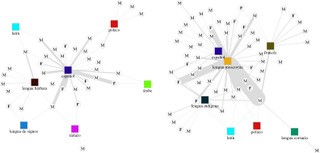/ News, Research
New Paper on Network Analysis applied to 17th. century Spanish Novels

The International Journal of Humanities and Arts Computing journal published the paper "Female Protagonism and Multilingualism in Spanish Byzantine Novels Analysed Using Character Networks" by José Luis Losada Palenzuela.
Is it possible to quantitatively identify the multilingual character and the position of female protagonists in novels using network analysis? The 17th century Spanish Byzantine genre shows tradicional two typical characteristics: the predominance of female characters and the explicit or implicit mention of foreign languages. Taking into account different network metrics together with the language attribution, we can compare the correlation between character importance and languages. The results confirm the hypothesis that the novels show a strong thematization of foreign languages, but that female heroines lag behind their male counterparts in protagonism.
In his role at RISE, José Luis Losada Palenzuela advises researchers on the design, implementation, and data management of humanities projects. A special focus is on quantitative literary research and digital editions.
Losada Palenzuela, J. L. (2023). Female Protagonism and Multilingualism in Spanish Byzantine Novels Analysed Using Character Networks. International Journal of Humanities and Arts Computing, 17(2), 168–186. https://doi.org/10.3366/ijhac.2023.0311
Quick Links
